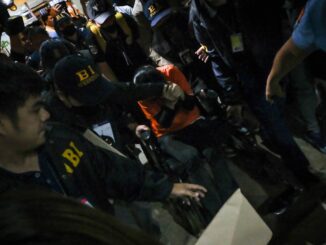
(UPDATES) ANOTHER Chinese research vessel has been detected inside the Philippines’ exclusive economic zone (EEZ).
Ray Powell, director of SeaLight, a maritime monitoring agency, said on Friday that the ship, Haiyang Dizhi Si Hao, has been conducting survey operations since August 14 north of Bajo de Masinloc or Scarborough Shoal.
Prior to being sighted off Bajo de Masinloc, the vessel was monitored inside Malaysia’s EEZ.
Ray Powell, director of SeaLight. PHOTOS BY J. GERARD SEGUIA
Powell said the ship was “running mostly dark, making it difficult to track.”
However, one Malaysian military official said the vessel spent two weeks inside Malaysian-controlled waters.
It was the second time in less than a month that a Chinese research vessel has ventured into the Philippine EEZ.
The Ke Xue San Hao was sighted surveying the areas south and east of Escoda (Sabina) Shoal in the West Philippine Sea beginning July 25.
Powell said the Ke Xue San Hao “traveled through the area around a host of submerged features south and east of Sabina Shoal, including First Thomas Shoal, Half Moon Shoal, Bombay Shoal, Royal Captain Shoal, Northeast Investigator Shoal and Boxall Reef.”
Powell said that based on satellite imagery, the ship passed within 600 meters of First Thomas Shoal, which is about 35 kilometers south of Ayungin (Second Thomas) Shoal, on July 29.
“This is the first recorded appearance of the Ke Xue San Hao in Philippine waters since May 2020, when it explored an area 60 nautical miles east of northern Luzon over a four-day period,” he said.
Powell said sending the survey ship to within 40 nautical miles of the coast of Palawan may be China’s way of “signaling its intent to keep the pressure on elsewhere in the West Philippine Sea despite loosening its blockade of the Philippine outpost (in Ayungin).”
A derelict navy ship, the Sierra Madre, serves as a station for a small detachment of Philippine soldiers.
Manila earlier warned that countries whose vessels are found conducting marine scientific research (MSR) activities in Philippine waters without the necessary clearance will be a subject of diplomatic protest.
The last MSR application was granted by the Department of Foreign Affairs (DFA) in December 2017 to China for research activities in northeastern Luzon and Mindanao.
China, meanwhile, is claiming that the Philippines plans to send a second coast guard vessel to anchor at Escoda Shoal, which the Chinese call Xianbin Jiao or Xianbin Reef, “in an attempt to construct a forward deployment base in the form of a semi-permanent floating platform.”
The Global Times, Beijing’s English-language newspaper, said the Philippines is planning to deploy the BRP Melchora Aquino to the Escoda Shoal “and attempt to join the MRRV-9701 (BRP Teresa Magbanua) in a joint anchoring.”
The Teresa Magbanua has been in the area since April.
Yang Xiao, deputy director of the Institute of Maritime Strategy Studies under the China Institute of Contemporary International Relations, said the Philippines plans “to further expand the established fact of expanding its occupation of the Xianbin Jiao, upgrade the scale of its semi-permanent floating platform, and in effect build a semi-grounded forward deployment base.”
Philippine Coast Guard (PCG) spokesman for the West Philippine Sea Commo. Jay Tarriela said China is “making these statements to shape perceptions among their domestic audience and the international community, asserting that they have legitimate claims over the entire South China Sea.”
“Simultaneously, they aim to distract the international community from their unlawful actions and aggressive behavior, which includes the deployment of China Coast Guard vessel in Escoda Shoal, alongside their numerous Chinese maritime militia and a Chinese research vessel that are clearly encroaching upon the Philippines’ exclusive economic zone,” Tarriela said.
The world’s largest coast guard ship, China Coast Guard’s (CCG) “The Monster,” ended its deployment to Escoda Shoal on August 11, where it had been anchored since July 31, within sight of the Teresa Magbanua.
The “Monster” was replaced by another CCG vessel, which is now stationed opposite the Teresa Magbanua, which is already surrounded by 6 Qiong Sansha Yu militia ships and about five other smaller militia vessels known as Spratly Backbone Vessels.
Tarriela said China’s claim that the Philippines is planning to establish a forward deployment base in Escoda Shoal was “too absurd to warrant a response.”
“Their suspicions about the Philippines engaging in such actions stem from their own pattern of unlawfully occupying maritime areas in the South China Sea, followed by illegal reclamation and provocative militarization of those features,” he said.
Powell said China may now be preparing to aggressively contest future PCG missions to Escoda Shoal, which is 75 nautical miles from Palawan.
On Friday, the National Task Force on the West Philippine Sea (NTF-WPS) commended members of the Senate for approving on third and final reading of Senate Bill 2665, or the Archipelagic Sea Lanes (ASL) Bill.
The task force said the move by the Senate is in “lockstep” with the efforts of the House of Representatives, which passed its version of the Senate bill, House Bill 9034, in December 2023.
It said such legislation will help further define the Philippine maritime domain and the need for strategic investments in maritime security, awareness and law enforcement, the sustainability of marine resources and protection of the marine environment.





Be the first to comment